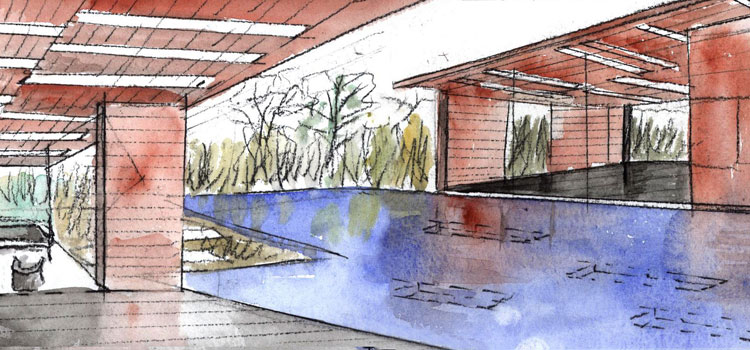Proyecto: Daeyang Gallery & House
Arquitecto: Steven Holl
Arquitecto local: JongSeo Lee, Inho Lee, Minhee Chung, Hyoungil Kim
Director proyecto: Annette Goderbauer, Chris McVoy
Equipo proyecto: Francesco Bartolozzi, Marcus Carter, Nick Gelpi, Jackie Luk, Fiorenza Matteoni, Rashid Satti, Dimitra Tsachrelia
Situación: Gangbuk-gu, Seul, Corea del Sur
Superficie terreno: 5.774 ft2
Estado: En construcción
Cliente: Daeyang Shipping Co. Ltd.
Constructor: Jehyo
Estructura: SQ Engineering
Instalaciones: L’Observatoire International
Ingeniería: Buksung HVAC+R Engineering
La galería y la casa están situadas en las colinas de la sección Kangbuk de Seúl, Corea. El proyecto fue diseñado como un experimento paralelo a un estudio de investigación sobre «la arquitectura de la música». La geometría básica del edificio está inspirado en una partitura del compositor Anhalt Istvan: «Sinfonía de los módulos», descubierto en un libro de John Cage titulado «Anotaciones».
Tres pabellones, uno para la entrada, una residencia y una casa de huéspedes. Una lámina de agua establece el plano de referencia de: arriba, abajo.
La idea del proyecto parte del silencio, siendo continuo hasta que es activado por la luz, realizado con 55 tiras en el techo. En cada uno de los pabellones, 5 tiras de vidrio transparente permite que la luz del sol ilumine los espacios interiores. La animación de la luz estará de acuerdo a la hora del día y la temporada en la que nos encontremos. Las proporciones se organizan en torno a las series 3, 5, 18, 13, 21, 34, 55.
Las vistas desde el interior de los pabellones se enmarcan en la piscina de reflexión que se encuentra entre corchetes creados por los jardines que son perpendiculares a las tiras de la claraboya.
Cualquier visitante llega con la continuación del muro del jardín que da acceso al patio de entrada, después de abrir la puerta principal. Él o ella puede dar vuelta para ver el estanque central en el nivel principal y tomar cualquier dirección dentro del conjunto de los tres pabellones que flotan en sus propias reflexiones.
Los interiores de los pabellones son de color rojo con las claraboyas a través de un techo de bambú rojo. Los exteriores son una lluvia de piel de bronce especialmente tratado que envejece de forma natural en el paisaje.
The private gallery and house is sited in the hills of the Kangbuk section of Seoul, Korea. The project was designed as an experiment parallel to a research studio on «the architectonics of music». The basic geometry of the building is inspired by a 1967 sketch for a music score by the composer Istvan Anhalt, «Symphony of Modules,» discovered in a book by John Cage titled «Notations».
Three pavilions; one for entry, one residence, and one guest house, appear to push upward from a continuous gallery level below. A sheet of water establishes the plane of reference from above and below.
The idea of space as silent until activated by light is realized in the cutting of 55 skylight strips in the roofs of the three pavilions. In each of the pavilions, 5 strips of clear glass allow the sunlight to turn and bend around the inner spaces, animating them according to the time of day and season. Proportions are organized around the series 3, 5, 18, 13, 21, 34, 55.
Views from within the pavilions are framed by the reflection pool which is bracketed by gardens that run perpendicular to the skylight strips. In the base of the reflecting pool, strips of glass lenses bring dappled light to the white plaster walls and white granite floor of the gallery below.
A visitor arrives through a bamboo formed garden wall at the entry court, after opening the front door and ascending a low stair. He or she can turn to see the central pond at eye level and take in the whole of the three pavilions floating on their own reflections.
The interiors of the pavilions are red and charcoal stained bamboo with the skylights cutting through a red bamboo ceiling. Exteriors are a rain skin of specially treated brass which ages naturally within the landscape.

